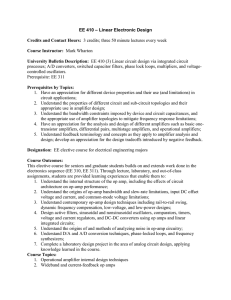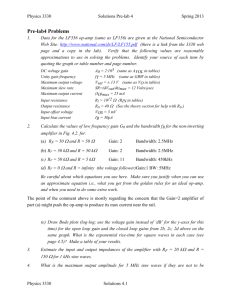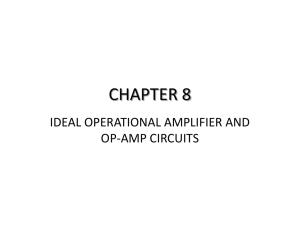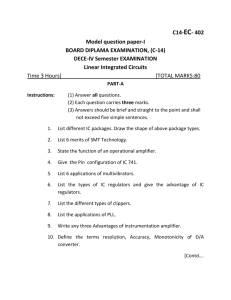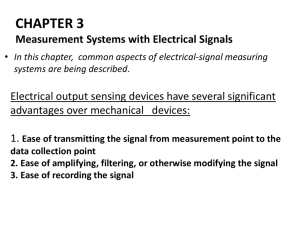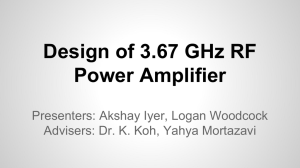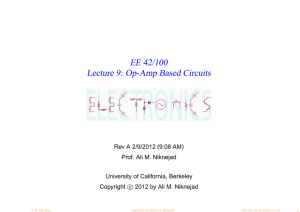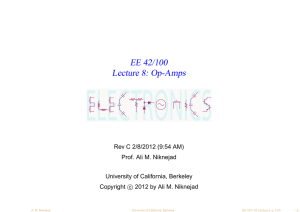Document
advertisement
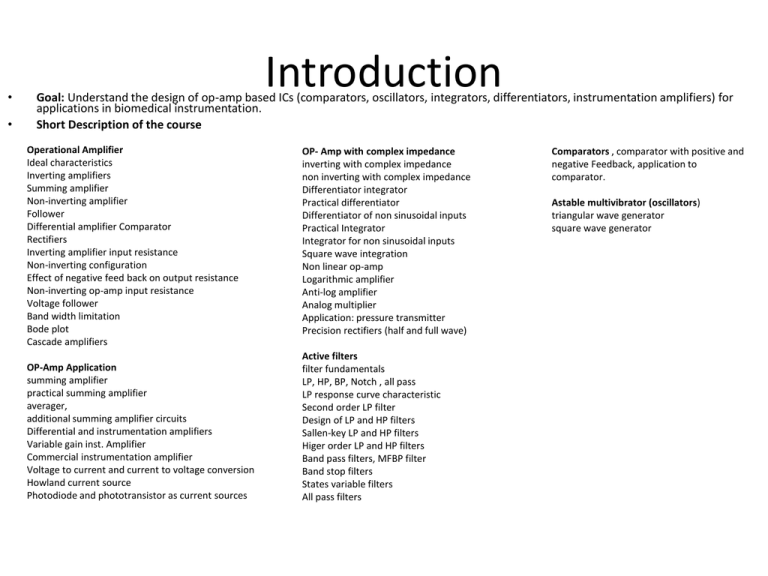
• • Introduction Goal: Understand the design of op-amp based ICs (comparators, oscillators, integrators, differentiators, instrumentation amplifiers) for applications in biomedical instrumentation. Short Description of the course Operational Amplifier Ideal characteristics Inverting amplifiers Summing amplifier Non-inverting amplifier Follower Differential amplifier Comparator Rectifiers Inverting amplifier input resistance Non-inverting configuration Effect of negative feed back on output resistance Non-inverting op-amp input resistance Voltage follower Band width limitation Bode plot Cascade amplifiers OP- Amp with complex impedance inverting with complex impedance non inverting with complex impedance Differentiator integrator Practical differentiator Differentiator of non sinusoidal inputs Practical Integrator Integrator for non sinusoidal inputs Square wave integration Non linear op-amp Logarithmic amplifier Anti-log amplifier Analog multiplier Application: pressure transmitter Precision rectifiers (half and full wave) OP-Amp Application summing amplifier practical summing amplifier averager, additional summing amplifier circuits Differential and instrumentation amplifiers Variable gain inst. Amplifier Commercial instrumentation amplifier Voltage to current and current to voltage conversion Howland current source Photodiode and phototransistor as current sources Active filters filter fundamentals LP, HP, BP, Notch , all pass LP response curve characteristic Second order LP filter Design of LP and HP filters Sallen-key LP and HP filters Higer order LP and HP filters Band pass filters, MFBP filter Band stop filters States variable filters All pass filters Comparators , comparator with positive and negative Feedback, application to comparator. Astable multivibrator (oscillators) triangular wave generator square wave generator Digital Vs Linear Electronics • Digital Electronics: All phases of electronics in which signals are represented in terms of finite number of digits (binary); all arithmetic computations on such numbers, as well as associated logic operations. • Linear (Non-digital) Electronics: All phases of electronics in which signals are represented by continuous or analog variables; all associated signal processing functions (e.g., amplification). – Nonlinear circuits also categorized in this category Ideal Amplifier • Output signal is directly proportional to input signal, but amplified • All amplifiers require dc power (bias) supplies to provide amplification + Vi(t) - Linear Amplifier (voltage gain = A) • Voltage gain A= V0(t) / Vi(t) V0(t) = A Vi(t) + Vo(t) - Source Models • Ideal sources: independent of any external loads • Practical sources: combination of ideal sources and one or more passive components (resistance) – – – – is = Vs / Rs (short circuit) Vs = isRs (open-circuit) Thevenin model: Rs < Rload Norton model: Rs > Rload Ideal voltage and current source models + is Vs - Thevenin and Norton models for practical sources + Vs - Rs is Rs Operational Amplifier (Op-Amp) • Most important single linear integrated circuit (building block of analog circuit field) • High-gain, integrated-circuit, direct-coupled amplifier • Linear and nonlinear signalprocessing function A component level diagram of the common 741 op-amp (Wikipedia.org( Op-Amp: power supply connections • Commonly used: dual power supplies • Common values: – +15V (+V or V+) – -15V (-V or V-) • All output loads connected between output terminal and common ground point • Usually power supply connections are omitted for ease Positive power supply terminal + 15 v + 15 v - Negative power supply terminal Common ground point Op-Amp: symbol and circuit model • Two signal input terminals – Inverting terminal (-) – Noninverting terminal (+) • One output signal terminal • Differential input voltage (Vd) • Output voltage Vo=AVd Inverting input terminal V- Output terminal Vd Vo V+ Noninverting input terminal V- + Vd = V+ - VAVd = A(V+ - V-) - V+ A∞ Vo Ideal Op-Amp • Input impedance of op-amp is ∞ – No current flow in or out of input terminals • Output impedance of op-amp (with respect to ground) is ‘0’ – Voltage V0 does not change with load • Open-loop gain A ∞ – Vd = V+ - V- = V0 / A – Since circuit is operated in linear stable mode, V0 must be finite voltage (usually 13 V) – As A ∞, Lim Vd = Lim (V0/A) = 0 – Vd0; V+ - V- = 0; V+ = V- Inverting Amplifier • Under stable linear operation – – – – Vd0 or V+ = VSince V+ = 0, V- = 0 (virtual ground) ii = Vi / Ri Since input current should be 0, ii flows through Rf – Vf =Rfii = Rf(Vi/Ri) = (Rf/Ri)Vi – Vo= -Vf = -(Rf/Ri)Vi – Closed loop voltage gain of circuit ACL = Vo/Vi = -(Rf/Ri) – Input impedance Rin = Vi/ii = Ri V- = 0 Rf ii ii + Vi - + Vf - Ri - + Vo
